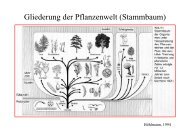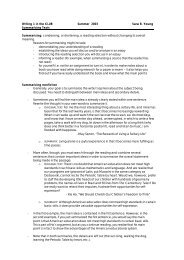Victorian Theatre
Victorian Theatre
Victorian Theatre
You also want an ePaper? Increase the reach of your titles
YUMPU automatically turns print PDFs into web optimized ePapers that Google loves.
<strong>Victorian</strong> <strong>Theatre</strong><br />
Jana Pöthke 23.05.05<br />
Julia Melchior
<strong>Victorian</strong> <strong>Theatre</strong>s<br />
19th century is the age of truly popular theatre<br />
<strong>Victorian</strong>s built some of the very large theatres:<br />
Drury Lane: 3,600 seating capacity (only West<br />
End theatre of that size)<br />
Britannia 3,900<br />
Pavilion 3,500<br />
Licensing Act allowed only 2 theatres in London to<br />
actually perform plays
Drury Lane <strong>Theatre</strong>
Changes in the<br />
<strong>Theatre</strong><br />
placing backs on benches<br />
introduction of chairs in the pit<br />
orchestra stalls (1828)<br />
boxes remained but became fewer in number<br />
Lavish decoration of auditorium
Audience<br />
Audience: lower, middle and upper class<br />
people dressed up (expensive dresses,jewelry etc....)<br />
were primarily not interested in play, only in<br />
presenting themselves<br />
division of audience into box, pit and gallery<br />
box: aristocracy & the fashionable<br />
pit: lawyers, critic, students and tradesmen<br />
gallery: servants, apprentices and journeymen
Conditions in the<br />
<strong>Theatre</strong><br />
atmosphere: very hot, dry, smelly, lacking oxygen<br />
seats jammed closely together<br />
foyer space sacrificed to bar space<br />
dressing rooms and other facilities for performers<br />
quite inadequate, sometimes downright dangerous<br />
every theatre in Britain had become a potential<br />
death trap
On Stage<br />
introduction of orchestra<br />
stalls<br />
forestage was shortened<br />
final <strong>Victorian</strong> form:<br />
picture frame stage<br />
as it looks today
On Stage<br />
desire for greater artistic consistency in<br />
setting and costume<br />
urge to wrap stage and players in historically<br />
authentic clothing<br />
stage was fully and handsomely furnished<br />
three dimensional scenery
Machinery<br />
gridiron: at the very top of the backstage space,<br />
high above the stage<br />
for everything that had to be raised, lowered and<br />
hung out of sight of the audience<br />
machinery beneath the stage responsible for<br />
everything appearing from beneath the stage or<br />
sinking through it<br />
Flying, not only of scenery but also of actors
Lighting<br />
within 2 generations from candles and oil lamps to<br />
electricity<br />
1st: use of wax candles<br />
1817: Drury Lane used gas lighting for stage and<br />
auditorium<br />
blacking out the auditorium while play is in progress<br />
might be lowered for special effects : ghostly vision,<br />
moonlit scene<br />
1881: Savoy <strong>Theatre</strong> was the first to be lit entirely by<br />
electricity
<strong>Victorian</strong> Melodrama<br />
Became fashionable during 1780s and 1790s<br />
Grew out of burletta (comic opera), retained<br />
musical elements- therefore no play.<br />
Basic character stereotypes (recognizable<br />
immidiately): spotless hero, black villain, maiden in<br />
white, motley fool.<br />
Sensational, special effects (train crash, explosions,<br />
fire, balloon ascent, underwater scenes, star traps...)<br />
Became so popular that they were even produced in<br />
patent theatres.
Shakespeare<br />
<strong>Victorian</strong> people loved costume dramas<br />
‚good theatre‘: historical intrigue in 5 acts,<br />
accurate costuming, lavish scenery<br />
Edited older dramas to fit this format,<br />
especially Shakespeare.<br />
Changed settings, endings and dialogues that<br />
seemed unfitting to them.
Cup and Saucer Drama<br />
Also:<br />
‚Drawing<br />
room comedy‘<br />
Stage: real<br />
room with<br />
doors, sofas<br />
tables.
Cup and Saucer Drama<br />
1879 instigated by Squire Bancroft & Marie Wilton<br />
in Haymarket theatre<br />
Dealt seriously with issues of the day, actors spoke,<br />
instead of declaming. Not much action on stage,<br />
instead conversations.<br />
In „The Vícarage“ an actor made tea- gave name to<br />
the genre
Music Halls<br />
Competition to the theatre, opened in 1852,<br />
developed from saloon entertainment and all-male<br />
drinking clubs
Music Halls<br />
Audience seated at tables, food and drinks served,<br />
performances on platforms at the side.<br />
Primarily drinking houses with added entertainment<br />
No real plays performed, but songs, comic acts and<br />
all kinds of weird acts.
Gilbert and Sullivan<br />
comic operas of William Gilbert and Arthur<br />
Sullivan are some of the best loved, and<br />
most well-known works in the history of<br />
musical theatre
Arthur Sullivan William Gilbert
Gilbert and Sullivan<br />
Sullivan composed the music<br />
Gilbert wrote and directed the operas<br />
Between 1871 and 1896 they wrote fourteen<br />
comic operas<br />
Were most successful when working<br />
together, e.g.: Thespis; Trial by Jury; H.M.S.<br />
Pinafore

















